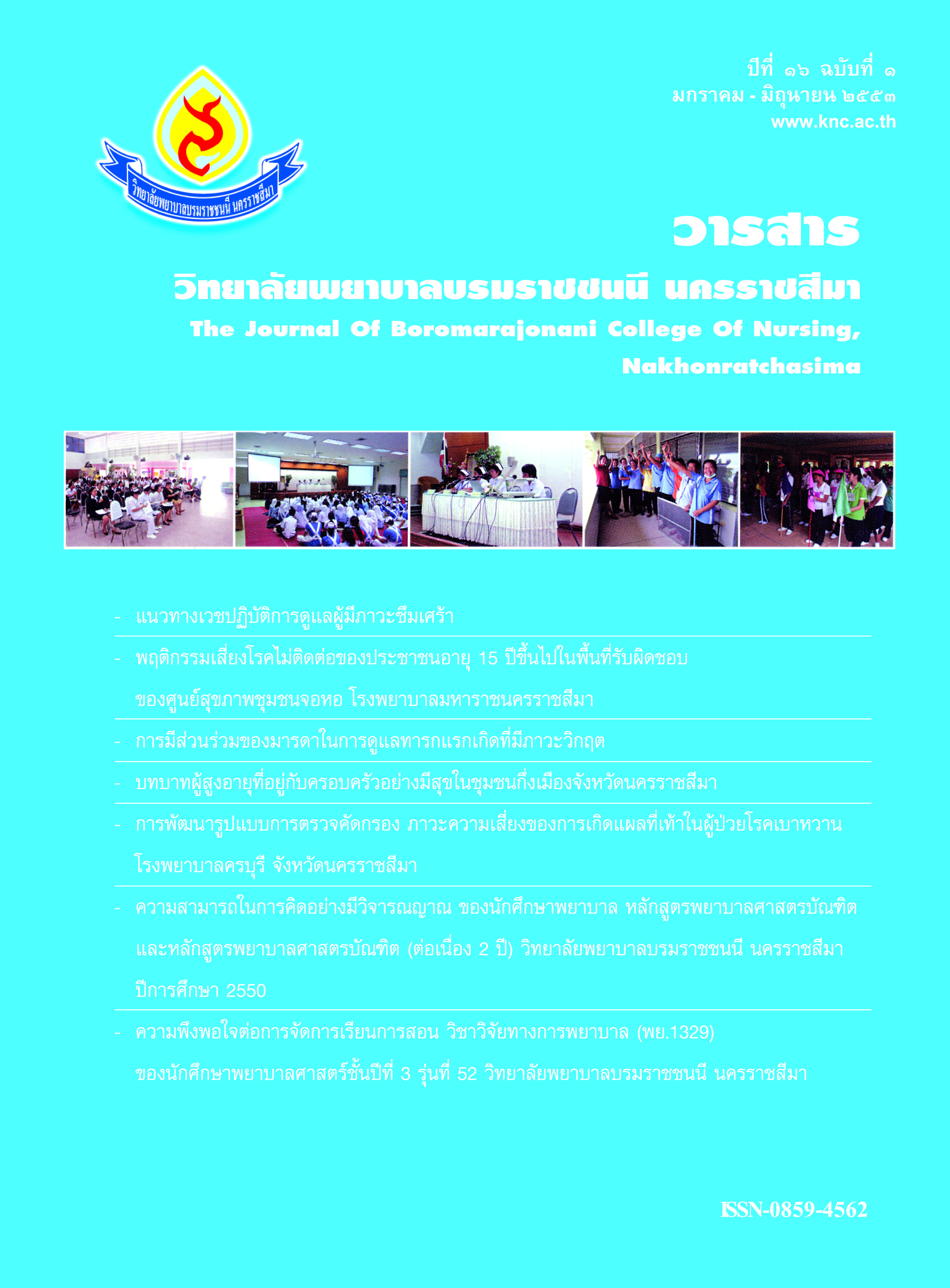พฤติกรรมเสี่ยงต่อโรคไม่ติดต่อของประชาชนอายุ 15 ปี ขึ้นไป ในพื้นที่รับผิดชอบของศูนย์สุขภาพชุมชนจอหอ โรงพยาบาลมหาราชนครราชสีมา
คำสำคัญ:
พฤติกรรมเสี่ยง, โรคไม่ติดต่อ, ศูนย์สุขภาพชุมชน, risk behaviors, non-communicable diseases, primary care unitบทคัดย่อ
บทคัดย่อ
การเปลี่ยนแปลงทางเศรษฐกิจและสังคมส่งผลกระทบต่อการดำรงชีวิตของประชาชน และเป็นปัจจัยเสี่ยงต่อการเจ็บป่วยด้วยโรคไม่ติดต่อเรื้อรัง การศึกษานี้เป็นเชิงพรรณนาเพื่อศึกษาสถานะสุขภาพ การเข้าถึงบริการ ความชุกของพฤติกรรมเสี่ยงต่อการเกิดโรคไม่ติดต่อเรื้อรัง และสำรวจความพึงพอใจต่อการรับบริการของประชาชนอายุ 15 ปี ขึ้นไปในพื้นที่รับผิดชอบของศูนย์สุขภาพชุมชนจอหอ โรงพยาบาลมหาราชนครราชสีมา จ.นครราชสีมา กลุ่มตัวอย่างได้มาจากการสุ่มอย่างเป็นระบบ จำนวน 630 คน เก็บรวบรวมข้อมูลในเดือน กุมภาพันธ์ 2552 โดยใช้แบบสัมภาษณ์ที่ผู้วิจัยพัฒนาขึ้น วิเคราะห์ข้อมูลเป็นร้อยละ ผลการศึกษาพบว่า ประชาชนส่วนมากประเมินสถานะสุขภาพตนเองอยู่ในระดับดีเยี่ยม (ร้อยละ 45.90) สามารถเข้าถึงบริการสุขภาพผ่านระบบการประกันสุขภาพได้ (ร้อยละ 96.50) พฤติกรรมเสี่ยงต่อการเกิดโรคไม่ติดต่อเรื้อรัง 3 ลำดับแรกได้แก่ ไม่ออกกำลังกายหนักมาก (ร้อยละ 74.60) การมีภาวะอ้วน (ร้อยละ 39.10) และมีระดับไขมันในเลือดสูง (ร้อยละ 38.60) โรคไม่ติดต่อเรื้อรังที่พบมากที่สุด 3 อันดับแรก คือ ความดันโลหิตสูง (ร้อยละ 24.60) โรคข้ออักเสบเกาต์ หรือรูมาตอยด์ (ร้อยละ 21.50) ปวดหลัง ปวดเอว ปวดเข่า มีข้อจำกัดในการทำกิจกรรมประจำวันและต้องใช้อุปกรณ์ช่วย (ร้อยละ 13.00) ส่วนการรับบริการทางสุขภาพพบว่าประชาชน ร้อยละ 76.30 เคยมาใช้บริการ และ ร้อยละ 84.40 มีความพึงพอใจต่อการบริการ จากผลการศึกษาดังกล่าวบุคลากรทางสุขภาพจึงควรจัดบริการเชิงรุกเข้าไปในพื้นที่เพื่อดูแลกลุ่มเป้าหมายที่เป็นกลุ่มเสี่ยง
คำสำคัญ : พฤติกรรมเสี่ยง, โรคไม่ติดต่อ, ศูนย์สุขภาพชุมชน
Abstract
Dramatic economic and social changes influence Thai people’s lifestyles, which can cause risk behaviors for non-communicable diseases. This descriptive study aimed to determine individual’s health status, health service accessibility and satisfaction, and prevalence of risk behaviors for non-communicable diseases. The population of this study was people who were more than 15 years old and lived in the responsible area of Jorhor PCU, Maharat Nakon Ratchasima Hospital, Nakon Ratchasima. A sample of 630 participants was selected using systemically random sampling. Data was collected in February 2009 by using an interview guide developed by researchers and then analyzed by percentage. Results show that most people rated their health status very high (45.90%) and were able to access health care services through their own health insurance system (96.5%). The three most-frequent risk behaviors that potentially caused non-communicable diseases were no physical activity (74.60%), obese (39.10%), dyslipidemia (38.60%). The most-prevalent three non-communicable diseases diagnosed by the doctors were hypertension (24.60%), gouty or rheumatoid arthritis (21.50%), and pain from back, knee, or other conditions that limited daily routine (13.00%). Among participants, 76.30 percent obtained services from the hospital and 84.40 percent were satisfied with the hospital services. According to the results, health care providers should provide progressive services for people in the risk group in the responsible areas.
Keyword : risk behaviors, non-communicable diseases, primary care unit
ดาวน์โหลด
ฉบับ
ประเภทบทความ
สัญญาอนุญาต
บทความที่ได้รับการตีพิมพ์เป็นลิขสิทธิ์ของ วารสารสุขภาพและการศึกษาพยาบาล ซึ่งดำเนินการโดยวิทยาลัยพยาบาลบรมราชชนนี นครราชสีมา
ข้อความที่ปรากฏในบทความในวารสารเล่มนี้เป็นความคิดเห็นส่วนตัวของผู้เขียนแต่ละท่านไม่เกี่ยวข้องกับกองบรรณาธิการวารสารสุขภาพและการศึกษาพยาบาล หรือวิทยาลัยพยาบาลบรมราชชนนี นครราชสีมา แต่อย่างใด ความรับผิดชอบองค์ประกอบทั้งหมดของบทความแต่ละเรื่องเป็นของผู้เขียนแต่ละท่าน หากมีความผิดพลาดใดๆ ผู้เขียนแต่ละท่านจะรับผิดชอบบทความของตนเองแต่ผู้เดียว







